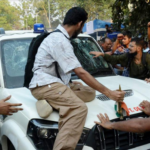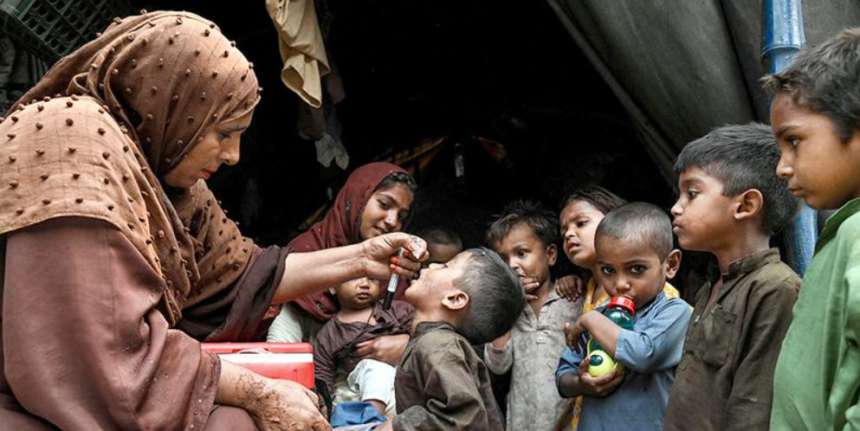Introduction
In a concerning development for public health, Pakistan recently reported two new Polio Cases, bringing the total count to 45 cases this year. Despite extensive eradication efforts and vaccination campaigns, polio remains a persistent challenge in Pakistan, one of only two countries in the world where the disease is still endemic. This increase in cases highlights the obstacles faced by healthcare authorities, ranging from logistical difficulties to vaccine hesitancy, and underscores the urgent need for innovative strategies to overcome these hurdles and finally eliminate polio from the country.
This article examines the reasons behind the recent rise in polio cases in Pakistan, the government’s eradication efforts, the challenges posed by vaccine hesitancy and misinformation, and what lies ahead in the fight against this paralyzing disease.
Understanding Polio and the Importance of Eradication
Polio, or poliomyelitis, is a viral disease that primarily affects children under the age of five, causing lifelong paralysis or even death in severe cases. There is no cure for polio, and prevention through vaccination is the only effective method to stop its spread. The World Health Organization (WHO) and various global health agencies have been working tirelessly to eradicate polio worldwide, with remarkable success in most regions. However, Pakistan remains one of the last strongholds of the disease, posing a threat not only to its population but to global eradication efforts.
In Pakistan, the type 1 wild poliovirus remains the main concern. This year’s resurgence in polio cases is a stark reminder of the challenges involved in achieving eradication, despite Pakistan’s longstanding and collaborative efforts with international health organizations.
The Recent Surge in Polio Cases in Pakistan: An Overview
As of the latest report, Pakistan has recorded a total of 45 polio cases in 2023, with the two new cases adding to this year’s tally. The majority of these cases have emerged from the Khyber Pakhtunkhwa (KP) province, particularly in remote and underserved areas. KP, with its rugged terrain and security challenges, remains one of the most challenging regions for vaccination drives.
Health officials attribute the increase in cases to multiple factors, including gaps in immunization coverage, transient populations, and obstacles created by socio-political issues. Polio transmission in Pakistan is influenced by both natural and man-made barriers, with seasonal migrations, urban overcrowding, and security concerns compounding the issue.
Key Challenges in Pakistan’s Polio Eradication Efforts
1. Vaccine Hesitancy and Misinformation:
One of the primary challenges to eradicating polio in Pakistan is vaccine hesitancy fueled by widespread misinformation. In many rural and conservative areas, misinformation about the vaccine’s safety and its alleged side effects leads to parental reluctance to vaccinate their children. Some communities believe that the vaccine could cause infertility or other health issues, misconceptions that have proven difficult to dispel despite government and NGO efforts to educate the public.
Anti-vaccine propaganda, often spread through social media and word of mouth, has also contributed to this hesitancy. In recent years, Pakistani authorities have worked to counter these myths through awareness campaigns, but overcoming deep-rooted suspicions has been an ongoing struggle.
2. Security Challenges in Conflict-Prone Areas:
Security concerns, particularly in regions like Khyber Pakhtunkhwa and Balochistan, present another formidable barrier to polio eradication. The threat to polio vaccination teams, especially in areas affected by militancy, has deterred vaccination workers and, in some cases, led to temporary halts in immunization drives. Polio workers, often viewed with suspicion, have been targeted in violent attacks, leading to casualties among healthcare workers and discouraging others from joining the campaign.
These security issues not only limit access to children who need vaccinations but also strain the government’s resources, as additional security measures are required to protect vaccination teams.
3. Geographical and Logistical Hurdles:
Pakistan’s diverse and rugged terrain poses logistical challenges that make it difficult to reach every child. Remote areas with limited infrastructure and inaccessible routes, particularly in mountainous regions, hinder the delivery of vaccines. Seasonal migrations and a highly mobile population in provinces like Sindh and Balochistan further complicate efforts, as tracking and re-vaccinating children who have missed doses becomes challenging.
Additionally, inconsistent power supply and extreme weather conditions affect the cold chain system needed to keep vaccines viable, resulting in spoiled vaccines that cannot be administered. 
4. Political Instability and Funding Issues:
Political instability and frequent changes in government policies have affected the consistency of Polio Cases campaigns. While international agencies such as WHO and UNICEF support Pakistan’s polio eradication initiatives, local political factors sometimes hinder effective coordination. Changes in government priorities can divert funds and attention away from polio, making it difficult for health departments to maintain the necessary momentum to eradicate the disease.
Furthermore, the COVID-19 pandemic stretched healthcare resources thin, as many health professionals and funds were redirected to manage the pandemic, temporarily disrupting the polio immunization programs.
Government and International Efforts to Combat Polio
Despite these challenges, Pakistan’s government, along with international agencies, has launched several initiatives aimed at tackling the recent surge in polio cases. The Pakistan Polio Cases Eradication Program, in collaboration with WHO, UNICEF, and the Global Polio Cases Eradication Initiative (GPEI), has intensified its efforts in the following ways:
1. Targeted Vaccination Campaigns:
To address gaps in immunization, authorities have organized targeted campaigns, focusing on high-risk areas and frequently missed populations. These drives prioritize polio-endemic regions, including areas in Khyber Pakhtunkhwa and Balochistan, where cases have been most prevalent. Vaccination teams have been deployed to remote villages and urban slums to administer doses to children who missed routine immunization.
2. Community Engagement and Awareness Programs:
Recognizing the importance of building trust, the government has ramped up its community engagement efforts. Collaboration with local leaders, religious figures, and community influencers has proven effective in encouraging vaccinations. Health workers have been trained to conduct door-to-door campaigns, directly addressing parents’ concerns about vaccine safety and dispelling misinformation.
Media campaigns, including radio broadcasts, social media, and television ads, are also in place to counter anti-vaccine narratives. By focusing on the safety and necessity of the Polio Cases vaccine, these initiatives aim to educate the public and increase acceptance of vaccination programs.
3. Enhanced Security Measures for Vaccination Teams:
In high-risk regions, the government has implemented additional security protocols to protect Polio Cases workers. Law enforcement agencies have been assigned to accompany vaccination teams, ensuring that they can carry out their duties safely. While this has not completely eradicated the threat of violence, it has made it possible for health workers to reach otherwise inaccessible areas.
To address potential backlash, authorities are also working with local communities to create a more positive perception of vaccination teams. Establishing trust and ensuring safety are key elements of the government’s strategy to overcome the barriers presented by militancy and suspicion.
4. Innovative Tracking and Data Collection:
Pakistan’s polio eradication teams are increasingly using technology to improve the efficiency and effectiveness of their campaigns. Mobile applications and data tracking tools help identify areas with low vaccination coverage and ensure that no child is missed. The collection of real-time data enables health officials to respond quickly to emerging cases and prevent further spread of the virus.
By mapping out high-risk zones and monitoring vaccine distribution, Pakistan’s polio teams can better strategize and allocate resources where they are needed most.
Global Support and the Role of International Agencies
The international community has been instrumental in supporting Pakistan’s efforts to eradicate polio. Agencies such as WHO, UNICEF, and GPEI have provided financial resources, vaccines, and technical expertise, enabling Pakistan to sustain its vaccination programs. These organizations also assist in public awareness initiatives and collaborate with local health authorities to address vaccine hesitancy.
In recent years, the GPEI has allocated funds specifically for addressing Pakistan’s unique challenges, such as security concerns and logistical issues. By working closely with Pakistani authorities, international agencies ensure that the polio eradication campaign remains a priority on the national agenda.
Looking Ahead: Future Strategies and the Path to Eradication
Eradicating Polio Cases in Pakistan requires sustained, coordinated efforts and the commitment of both the government and the public. Key strategies that could enhance the success of Pakistan’s polio eradication campaign include:
- Expanding Community-Based Programs: Engaging communities through grassroots programs, including training local volunteers and health workers, can help build trust and ensure more consistent vaccination. By integrating local leaders and influencers into the process, health teams can make strides in breaking down resistance to vaccines.
- Integrating Polio Vaccination into Broader Health Initiatives: Combining Polio Cases vaccination with other health services, such as maternal and child healthcare, could increase vaccination coverage. When parents see tangible health benefits beyond polio protection, they may be more receptive to vaccines.
- Strengthening Surveillance Systems: Improving Pakistan’s Polio Cases surveillance systems is essential for timely detection and containment of cases. Regular environmental sampling in high-risk areas and timely reporting of cases are critical for understanding polio transmission patterns and implementing effective responses.
- Increasing Investment in Health Infrastructure: Long-term eradication efforts require a robust healthcare system capable of responding to public health threats. Investments in healthcare infrastructure, particularly in underserved regions, can help Pakistan maintain high immunization rates and prevent the spread of diseases like polio.
Conclusion: A Final Push Toward Eradication
The resurgence of polio cases in Pakistan is a reminder of the complex challenges that continue to stand in the way of global Polio Cases eradication. With 45 cases recorded so far this year, Pakistan’s health authorities and their international partners are intensifying efforts to protect the country’s children from the disease. While issues such as vaccine hesitancy, security challenges, and logistical hurdles persist, the commitment of dedicated health workers, community leaders, and international agencies provides hope.
Pakistan’s path to becoming polio-free will require continued vigilance, innovation, and collaboration. By addressing the underlying challenges and strengthening public trust in vaccination programs, Pakistan has the potential to reach the milestone of Polio Cases eradication, contributing to a healthier, polio-free future for children across the country and the world. ALSO READ:- India Cancels Intra-Squad Match Against India-A Ahead of Border-Gavaskar Trophy: Strategic Decision or Missed Opportunity?





